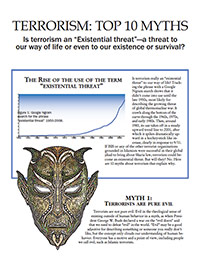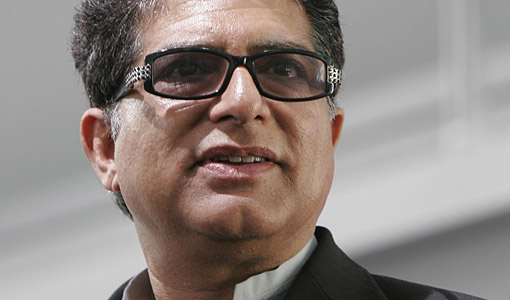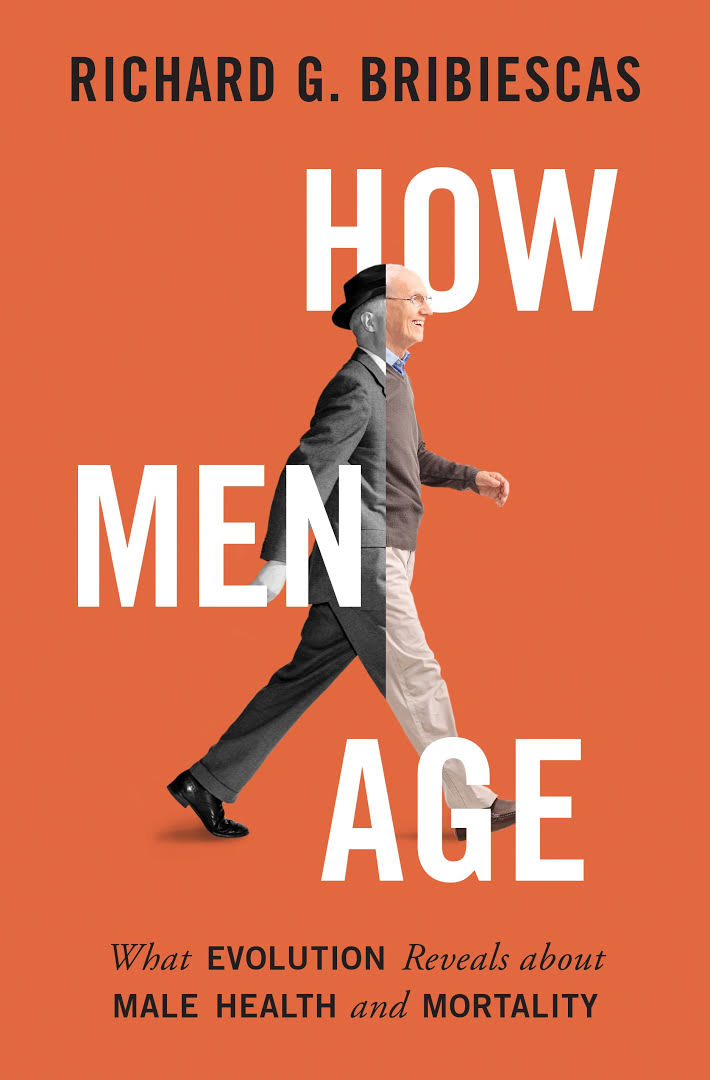Deities for Atheists, Skygods for Skeptics: UFOs & ETIs
Dr. Michael Shermer distinguishes between two questions: (1) Are extraterrestrial intelligences (ETIs) out there somewhere in the cosmos? and (2) Have aliens come here? Evidence for both questions is considered in the larger context of why the issue so compels us to answer it almost religiously.
Skepticism 101: How to Think Like a Scientist covers a wide range of topics, from critical thinking, reasoning, rationality, cognitive biases and how thinking goes wrong, and the scientific methods, to actual claims and whether or not there is any truth to them, e.g., ESP, ETIs, UFOs, astrology, channelling, psychics, creationism, Holocaust denial, and especially conspiracy theories and how to think about them.
If you missed Dr. Shermer’s previous Skepticism 101 lectures watch them now.
Mentioned in this lecture
- Skeptic 9.3 — A.I. and Theology of UFOs
- Skeptic 10.1 — Roswell Requiem
- Skeptic 11.1 — Medieval UFOs?
- Skeptic 16.4 — The Man Who Invented Flying Saucers
- Skeptic 18.4 — Ancient Aliens
Related Reading
- UFOs, Chemtrails, and Aliens: What Science Says
- Junior Skeptic 37: Busted Myths
- Junior Skeptic 57: Space Brothers from Venus
Cults, Myths, and Religion
Dr. Michael Shermer considers the characteristics of cults, how they differ from sects, religions, and myths, the role that myths and religions play in culture and people’s lives, and what Scientologists really believe.
Skepticism 101: How to Think Like a Scientist covers a wide range of topics, from critical thinking, reasoning, rationality, cognitive biases and how thinking goes wrong, and the scientific methods, to actual claims and whether or not there is any truth to them, e.g., ESP, ETIs, UFOs, astrology, channelling, psychics, creationism, Holocaust denial, and especially conspiracy theories and how to think about them.
If you missed Dr. Shermer’s previous Skepticism 101 lectures watch them now.
TAGS: belief, cults, mythology, religion, Scientology, skepticism 101 lecturesCognitive Biases & How Thinking Goes Wrong
Dr. Michael Shermer reviews the many ways that our attempts to understand the truth about the world are derailed by cognitive biases, including the anchoring bias, the representative bias, the availability bias, the confirmation bias, the hindsight bias, the self-serving bias, and even the bias bias.
This lecture is part of a course that Dr. Shermer teaches at Chapman University called Skepticism 101: How to Think Like a Scientist which covers a wide range of topics, from critical thinking, reasoning, rationality, cognitive biases and how thinking goes wrong, and the scientific methods, to actual claims and whether or not there is any truth to them, e.g., ESP, ETIs, UFOs, astrology, channelling, psychics, creationism, Holocaust denial, and especially conspiracy theories and how to think about them.
If you missed Dr. Shermer’s previous Skepticism 101 lectures watch them now.
Resources mentioned in this lecture
- Why People Believe Weird Things
- The Believing Brain
- Skeptic 24.3 — Steven Pinker on Post-truth & Reason
What Can Science Learn from Religion?
Steven Pinker on Religious Beliefs & Rituals
On Sunday February 3 the New York Times ran an Opinion Editorial by David DeSteno, a professor of psychology at Northeastern University, Boston who “studies the ways in which emotions guide decisions and behaviors fundamental to social living.” The essay argues that scientists have much to learn from religious traditions because they “offer a rich store of ideas about what human beings are like and how they can satisfy their deepest moral and social needs.” DeSteno quotes Richard Dawkins, “a vocal critic of religion, has said that in listening to and debating theologians, he has ‘never heard them say anything of the smallest use.’ Yet it is hubristic to assume that religious thinkers who have grappled for centuries with the workings of the human mind have never discovered anything of interest to scientists studying human behavior.” DeSteno continues:
Just as ancient doesn’t always mean wise, it doesn’t always mean foolish. The only way to determine which is the case is to put an idea—a hypothesis—to an empirical test. In my own work, I have repeatedly done so. I have found that religious ideas about human behavior and how to influence it, though never worthy of blind embrace, are sometimes vindicated by scientific examination.
Religious ideas that lead to testable hypotheses, DeSteno proposes, include: meditation (to reduce suffering and increase moral behavior), ritual (leading to greater self-control), and virtues such as gratitude and kindness. He also praises the Jewish practice of Shabbat, which “stems from a divine command for a day of rest and includes ritualistic actions and prayers. But it’s also a cultural practice in which people take time out from the daily grind to focus on family, friends and other things that matter more than work.” While explaining “I am no apologist for religion,” DeSteno concludes: “Science and religion do not need each other to function, but that doesn’t imply that they can’t benefit from each other.”
Also quoted in the essay is the Harvard psychologist Steven Pinker, whom I queried as to the full context of the quotes. Here is Pinker’s full reply to DeSteno’s question about what science can learn from religion through testable hypotheses about human behavior:
I’m not sure exactly how you’re conceiving of this question.
TAGS: enlightenment humanism, humanism, religion, scienceI assume you’re not referring to hypotheses such as that if a person accepts Jesus Christ as his savior he will spared eternal torment in hell, or that if Jewish men don phylacteries and Jewish women have their pubic hair inspected after they menstruate then the coming of the messiah will be hastened. These will be difficult to test, to put it mildly. Of course one could seek out more testable hypotheses, such as CONTINUE READING THIS POST…
Moral Philosophy and its Discontents
A response to Massimo Pigliucci’s critique of my Scientific American column on utilitarianism, deontology, and rights. (Illustration above by Izhar Cohen.)
My May 2018 column in Scientific American was titled “You Kant be Serious: Utilitarianism and its Discontents”, a cheeky nod to the German philosopher that I gleaned from the creators of the Oxford Utilitarianism Scale, whose official description for those of us who score low on the scale read: “You’re not very utilitarian at all. You Kant be convinced that maximizing happiness is all that matters.” The online version of my column carries the title (which I have no control over): “Does the Philosophy of ‘the Greatest Good for the Greatest Number’ Have Any Merit?” The answer by any reasonable person would be “of course it does!” And I’m a reasonable person, so what’s all the fuss about? Why was I jumped on by professional philosophers on social media, such as Justin Weinberg of the University of South Carolina on Twitter @DailyNousEditor, who fired a fusillade of tweets, starting with this broadside:
I sent a private email to Justin inviting him to write a letter to the editor of Scientific American that I could then respond to—given that Twitter may not be the best medium for a discussion of important philosophical issues—but I never received a reply.
Social media responses were following by a critical review by the noted scientist and philosopher (and fellow skeptic) Massimo Pigliucci (“Michael Shermer on utilitarianism, deontology, and ‘natural rights’” in his blog Footnotes to Plato that was 2.5 times the length of the original column. Because I respect Massimo (he and I have been friends since the mid 1990s) and I always appreciate it when people take my writings seriously enough to respond, allow me to explain what I was trying to do in this column (and all my columns) in general, address Massimo’s specific comments in particular, and then consider the larger issues in these competing ethical systems on the moral landscape.
1. Limits
For each of my Scientific American columns I try to find an interesting and important topic, considered within a larger theoretical framework, sparked by some new survey, study, article, or book, that includes my opinion (these columns are in the “Opinion” department of Scientific American), and is written in a manner engaging enough to hold the attention of busy readers. I have one page, or about 710 words, to do this. The July column was triggered by CONTINUE READING THIS POST…
TAGS: human rights, morality, natural rights, utilitarianismLife’s Score
ABOVE: The author in the 1984 Race Across America (RAAM), crossing from Arizona into Utah through the Virgin River Gorge.
Among cycling aficionados of my generation, Peter Yates’ and Steve Tesich’s 1979 film Breaking Away was a welcome vehicle to convey the elegance and complex strategy of our sport to an American audience largely oblivious to its beauty and nuances. Of course, like most sports films, it was a metaphor for something deeper, in this case a coming of age story of a young man struggling to break away from the provincialism of family and friends, along with a morality tale about how everyone lies a little and some people cheat a lot.
In Knowing the Score, King’s College philosopher David Papineau uses specific sports as metaphors for and lessons about many of the most important and contentious issues in philosophy and life. In his chapters on cycling, for example, he confesses his ignorance while watching the 2012 Olympic road race as to why four women cyclists from different countries would work together after their break away from the peloton. Papineau finds an answer in game theory, the analysis of competition and cooperation between rational actors in a conflict situation. The prisoner’s dilemma model is the most famous example: you and another prisoner are arrested for a crime with the following options: (1) If both of you remain silent then you each receive one year in jail; (2) If you confess but the other person does not, then you go free and he gets three years; (3) If the other prisoner confesses and you don’t, then you receive the three-year penalty while he goes free; (4) If you both confess then you each get two years. What should you do? Research shows that when the game is played just once, or over a fixed number of rounds without the players being allowed to communicate, defection (confessing) is the common strategy. But when the game is played over an unknown number of rounds the most common strategy is CONTINUE READING THIS POST…
TAGS: competition, cooperation, game theory, philosophy, prisoner’s dilemma, reviewSkeptic’s Science Dialogue:
with Bill Nye the Science Guy
with Bill Nye the Science Guy
This is the first in Skeptic’s new series of Science Dialogues. Skeptic magazine Publisher and Skeptics Society Executive Director Michael Shermer interviews Bill Nye the Science Guy about his new Netflix Original Series Bill Nye Saves the World. The new series airs Friday, April 21, 2017. The following interview took place on December 18, 2016 at the offices of the Planetary Society CONTINUE READING THIS POST…
TAGS: Bill Nye, Netflix, Science DialogueThe Ultimate Trade Off
Richard G. Bribiescas is a professor of anthropology and evolutionary biology at Yale University and his new book is the best short summation I have seen of a massive body of scientific research to address his title subject, How Men Age. Now that I am in my early 60s I find myself gravitating toward this literature, but this is not a how-to book. There is no men’s magazine-style bullet list of what older men should do to look and be young again. Bribiescas is a good scientist, and as such he makes it clear that all such studies are limited in scope, have exceptions, and the long-term consequences of any artificial interference with the aging process beyond diet and exercise are unknown. Caveat emptor! Here is what we know.
Aging is the decline in physiological function that occurs over a measurable passage of time, caused by a combination of physics, genes, disease, and other environmental assaults and stressors. Aging is highly heritable, which is why physicians and life insurance companies always ask about the age of your parents at death and the causes of their deaths. But there is no “gene for aging,” or even a suite of genes. Aging happens across most of the systems in your body and there’s only so much you can do to stave off its inevitable effects. Worse, tinkering with the aging process too much can lead to CONTINUE READING THIS POST…
TAGS: anti-aging, health, mortalityTop 10 Myths of Terrorism
As usual, each year, we give away an informative booklet to thank you for your generous donations. This year, our free booklet examines whether terrorism is an “existential threat” to our way of life or even to our survival.
The Rise of the Use of the Term “Existential Threat”

Click image to enlarge. The historic 60-inch telescope at the Mt. Wilson Observatory. We will be using this, or perhaps the even larger 100-inch telescope. (Photo by Heven729 (own work) [CC BY-SA 4.0], via Wikimedia Commons)
Is terrorism really an “existential threat” to our way of life? CONTINUE READING THIS POST…
TAGS: free download, mythology, terrorismThe “Mandela Effect”

Former President Nelson Mandela of South Africa met with US President George W. Bush in the Oval Office in 2005—and yet, according to some people’s memories, Mandela died two decades earlier. (White House photo by Eric Draper)
At Chapman University I teach an undergraduate course called Skepticism 101: How to Think Like a Scientist. One of the course requirements is that each student must do an 18-minute TED-style talk. It’s a good exercise in learning to give public talks, as well as organize your thoughts in a manner conducive to both critical thinking and clear communication. The first student TED talk was by Taryn Honeysett on something called “The Mandela Effect,” of which I was unfamiliar. The name comes from the mistaken belief that the great statesman and civil rights activist Nelson Mandela (1918–2013) died while in prison in the 1980s, and it is characterized by a group of people who all misremember something in a similar manner.
The effect gained a cultural toehold in an Internet forum discussion over the proper spelling of a popular children’s book and television series called The Berenstain Bears, when a number of people insisted the correct spelling was Berenstein. (The series began in 1962, with the first book edited and published by Dr. Seuss—aka Ted Seuss Geisel.) Other examples of The Mandela Effect involve the number of states in the United States (50 or 52, with a sizable number of people believing it is 52, probably mixing states in the U.S. with cards in a deck), the correct spelling of the word definitely (or definitly), and people’s recall of what Darth Vader said in Star Wars: “Luke, I’m your father” or “No, I’m your father” (it’s the latter, although I too remember it by the more effecting version that addresses the subject).
TAGS: alternate universes, Berenstain Bears, many worlds interpretation, skepticismQuantum Leaps

Deepak Chopra in 2006. (Image by Mitchell Aidelbaum, via Wikimedia Commons. Used under Creative Commons Attribution-Share Alike 2.0 Generic license. Cropped.)
In the Middle Ages scholars drew correspondences between the microcosm (the earth) and the macrocosm (the heavens), finding linkages between bodily organs, earthly minerals, and heavenly bodies that made the entire system interlocking and interdependent. Gold corresponds to the Sun, which corresponds to the Heart. Silver corresponds to the Moon, which corresponds to the Brain. Mercury corresponds to the planet Mercury, which corresponds to the Gonads. The four elements of Earth, Water, Air, and Fire were astrologically coupled to the four humor-based personality traits of melancholic, phlegmatic, sanguine, and choleric.
In March of 2010 Sam Harris and I participated in a debate with Deepak Chopra and Jean Houston at Caltech that was filmed by ABC’s Nightline and viewed by millions (video). Deepak hammered out a series of scientistic-sounding arguments for the existence of a nonlocal spooky-action-at-a-distance quantum force that reminded me of a Middle Ages-inspired correspondence between macrocosm world events and microcosm quantum effects, well captured in the following chart (inspired by my friend and colleague Stephen Beckner):
TAGS: consciousness, Deepak Chopra, quantum mechanics, quantum physics, Victor StengerThe Fifth Horseman: The Insights of Victor Stenger (1935–2014)
Victor J. Stenger was a particle physicist, philosopher, author, skeptic, and friend. I first came across his name shortly after we founded Skeptic magazine in 1992 when I read his 1990 book Physics and Psychics: The Search for a World Beyond the Senses (Prometheus Books), for which “psychic” Uri Geller sued (the case was dismissed and Geller was ordered to pay legal fees of nearly $50,000). Stenger’s 1995 book, The Unconscious Quantum: Metaphysics in Modern Physics and Cosmology, was especially helpful to us as we dealt with the burgeoning interest in the topic of quantum consciousness and the New Age fascination with the field as a way of using one of the most well-developed and thoroughly tested fields in all of science to prop up supernatural and paranormal beliefs with sciency sounding terms (the very definition of pseudoscience).
Victor was especially helpful to me in assessing the technical claims of the quantum consciousness proponents, such as those featured in the wildly popular film What the Bleep Do We Know?! It was a well produced film (I saw it in Portland with the producers after we were both on a radio show), but I never imagined it would become the big hit it did, given the esoteric nature of its subject: quantum physics and consciousness. But it had that New Agey uplifting anything-is-possible-if-you-wish-it-so feel. It included a number of talking head physicists, such as University of Oregon quantum physicist Amit Goswami, who proclaimed: “The material world around us is nothing but possible movements of consciousness. I am choosing moment by moment my experience. Heisenberg said atoms are not things, only tendencies.” In my Scientific American column on the film I challenged him to “leap out of a 20-story building and consciously choose the experience of passing safely through the ground’s tendencies.”
TAGS: consciousness, pseudoscience, science, tribute, Victor Stenger


![Knowing the Score: What sports can teach us about philosophy (and what philosophy can teach us about sports) [BOOK COVER]](https://www.skeptic.com/eskeptic/2017/images/17-08-09/knowing-the-score-cover.jpg)








